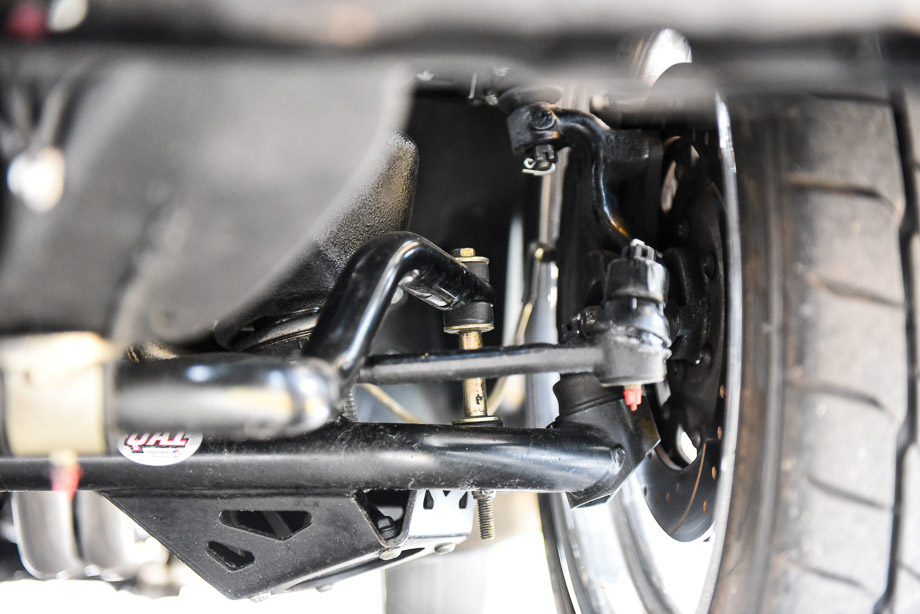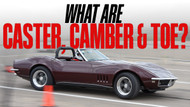The Importance Of Camber, Caster & Toe For Proper Alignment
Let's talk about something that many classic muscle car enthusiasts may not be aware of: the importance of proper alignment. Specifically, we're going to break down the three building blocks of alignment — caster, camber, and toe — and explain how they impact the way your classic muscle car handles.

Classic muscle cars were built with different standards and technology than modern cars, which means they have outdated alignment settings. As a result, these cars may not handle as well as they should, which can affect their overall performance and safety. That's where upgrading to modern suspension components, such as QA1 control arms, can make a big difference.
NOW, LET'S DIVE INTO THE THREE COMPONENTS OF YOUR ALIGNMENT
WHAT IS TOE?
Toe is the most straightforward component of your alignment. It simply refers to the direction your tires point. If your tires are perfectly parallel, you have zero toe. If the fronts of your tires point out (i.e. they're wider than the rear of your tires), you have toe out. If the fronts of your tires point in (i.e. they're narrower than the rears of your tires), you have toe in.
So, how does toe affect your car's handling? Well, zero toe can cause your car to wander a bit. A little bit of toe in, on the other hand, can give you more straight-line stability - which is why most street cars are going to have some toe in. Toe out can make your car very responsive when turning in, but it can also make your car feel darty. For this reason, track cars may run toe out.

WHAT IS CAMBER?
Camber refers to the angle of your wheels when viewed from the front of your car. If the tops of your tires tip in toward the center of your car, you have negative camber. If the tops of your tires tip out, you have positive camber.
When it comes to performance and handling, most applications are going to use a little bit of negative camber to get the best contact patch as that tire loads up during cornering. This helps improve your car's cornering ability and stability.
WHAT IS CASTER ANGLE?
Caster is a bit more complex than toe and camber, but it's just as important. The caster angle is the slope of an imaginary line that intersects the upper and lower steering pivot points, viewed from the side. This could be the upper and lower ball joints or the lower ball joint and the strut.
So, what does caster do? It affects three things:
Steering effort: Increasing the amount of positive caster will make turning the wheel more difficult. However, for vehicles with power steering systems, this is not really an issue.
Stability: More positive caster stabilizes the wheel at speed. It helps keep the vehicle traveling in a straight line. It also helps return the tire to an upright position when coming out of a turn.
Cornering: Positive caster increases the tire lean during a turn. When the tire leans into a turn, the vehicle corners better.
HOW DO TOE, CAMBER, AND CASTER WORK TOGETHER?
So, how do toe, camber, and caster work together to optimize your car's performance? In short, they ensure that your car handles well and stays stable at high speeds.
If you have an old car, updating its front end geometry to modern specs can completely transform the way it drives. For instance, you'll get a specific set of alignment specs when you install QA1 control arms. These are designed to update classic front ends to more modern configurations.
FINAL THOUGHTS
 Having proper alignment is crucial for your classic muscle car's performance and safety. The outdated alignment settings of these cars can cause them to handle poorly, which is where upgrading to modern suspension components like QA1 control arms can make a significant difference. Understanding the three components of alignment - toe, camber, and caster - and how they work together is essential to optimizing your car's performance and ensuring it stays stable at high speeds. With an updated front end geometry, you can completely transform the way your old car drives, making it handle and perform like a modern vehicle. So, if you're looking to improve your classic muscle car's performance, consider upgrading your alignment with QA1 control arms.
Having proper alignment is crucial for your classic muscle car's performance and safety. The outdated alignment settings of these cars can cause them to handle poorly, which is where upgrading to modern suspension components like QA1 control arms can make a significant difference. Understanding the three components of alignment - toe, camber, and caster - and how they work together is essential to optimizing your car's performance and ensuring it stays stable at high speeds. With an updated front end geometry, you can completely transform the way your old car drives, making it handle and perform like a modern vehicle. So, if you're looking to improve your classic muscle car's performance, consider upgrading your alignment with QA1 control arms.

